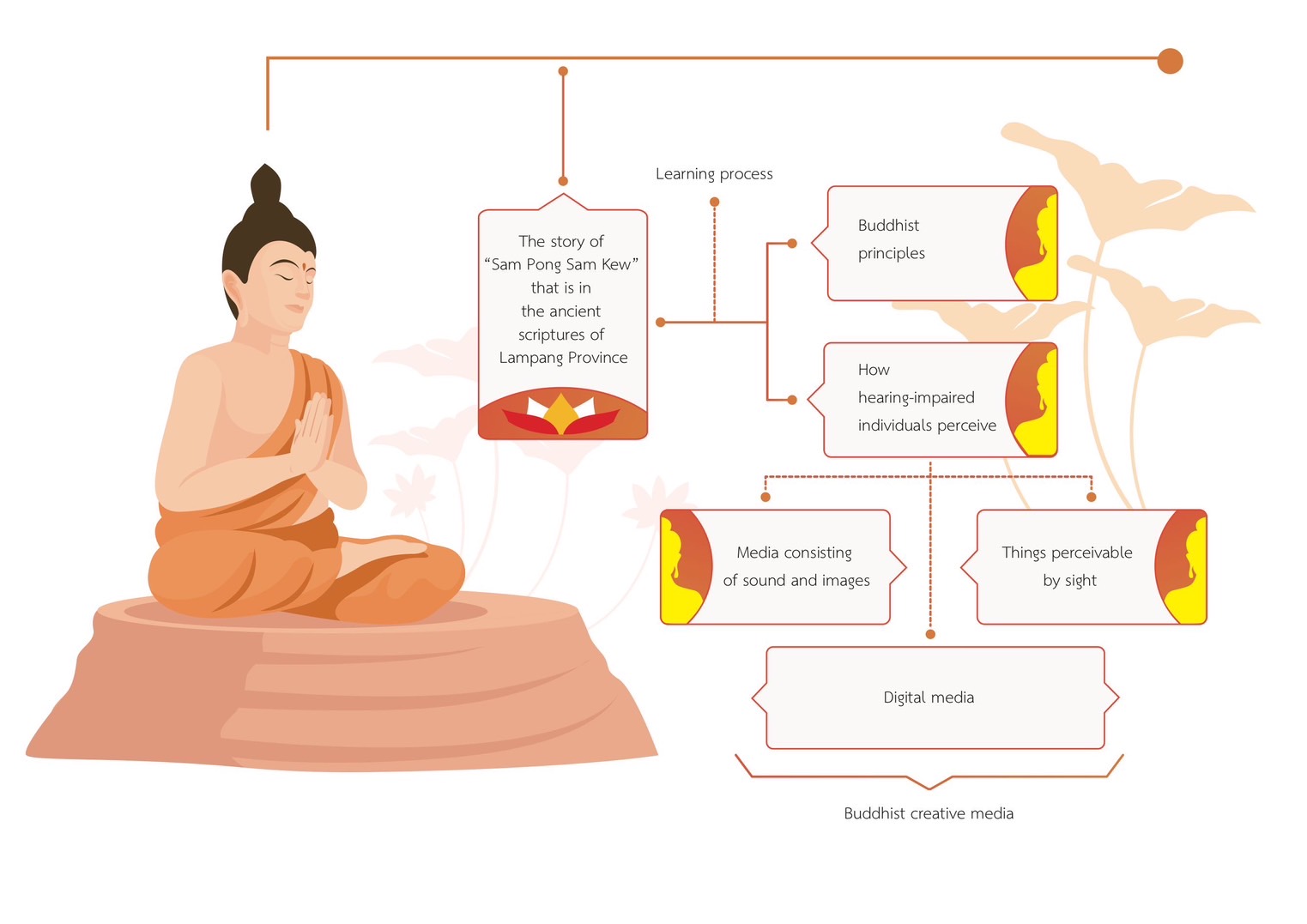SIGN LANGUAGE, DHAMMA LANGUAGE: INNOVATIONS IN TEACHING BUDDHISM TO HEARING-IMPAIRED INDIVIDUALS
Keywords:
Sign Language, Dhamma language, Innovation, Teaching Buddhism, Hearing-Impaired IndividualsAbstract
Background and Objectives: Hearing-impaired individuals are vulnerable persons in society.
Their vulnerability is closely linked to inequality and empowers hearing-impaired individuals to be immune to problems and obstacles. It includes Buddhist principles that help prevent and solve life problems efficiently. Hence, the researchers' group realizes the importance of folktales for soothing the human mind and disciplining the morality of humans. The folktales tactfully comprise the teaching of behavioral guidelines that are the basis of socializing. Therefore, the researchers are interested in studying the elements of innovations in teaching Buddhism to hearing-impaired individuals by creating innovations in teaching Buddhism to hearing-impaired individuals, determining the efficiency of innovations in teaching Buddhism to hearing-impaired individuals, and learning lessons. It is a set of knowledge to develop the potential of hearing-impaired individuals through innovations in teaching Buddhism by using multimedia, which is an animated cartoon with a sign language interpreter narrating the pictures.
Methodology: This research used mixed methods by studying information in documents. It includes concepts, theories, and related research. The researchers used the information as guidelines for creating research tools to use in data collection for analyzing and creating innovations in teaching Buddhism to hearing-impaired individuals.
Main Results: The innovations in teaching Buddhism to hearing-impaired individuals were the inventions for creating new methods in teaching Buddhism that could have developed the learning quality for learners and the learning management for teachers to be more efficient.
They took into account things perceivable by sight, the media consisting of sound and images, and digital media. The efficiency of the innovations in teaching Buddhism to hearing-impaired individuals through three aspects, which included content, digital media, design, or learning process, was found to have the mean values at the highest level.
Involvement to Buddhadhamma: The Buddhist principles that were innovative teaching methods for hearing-impaired individuals consisted of earnestness (Appamāda), three kinds of desires (Taṇhā), the five aggregates (Pañca-khandha), the advice on how to investigate a doctrine (Kālāmasutta), the four sublime states of mind (Brahmavihāra Dhamma), and the four paths of accomplishment (Iddhipāda). This research applied the principles of Buddhism with modern science in the field of the development of wisdom and morality by integrating them with the teaching methods for hearing-impaired students. There were groups of persons with disabilities who were interested in learning more about Buddhist principles through the creative media for hearing-impaired individuals. The innovations would have led to the development of life and intelligence to be prosperous, strengthening mental health to create social immunity amidst social conditions of increased fragility.
Conclusions: The innovations in teaching Buddhism within this study was regarded as a new body of knowledge. It took the northern folktales that appeared in ancient scriptures as a Buddhist creative media for teaching Buddhism. The purpose was to provide another channel of learning the Buddhist principles for hearing-impaired individuals. This creative media could have been applied to learning management in the subject field of Buddhism and local culture among educational institutions in order to physically and mentally immunize hearing-impaired individuals. In addition, it was also consistent with the mission of Mahachulalongkornrajavidyalaya University, which indicated that the university managed Buddhist education integrated with modern science to create Buddhist innovation for developing the mind and society.
References
Chaiworamankul, Y., Chaiwan, S., Phramaha Weeratis Warinto, Kamchusang, P. & Homtaunlom, T. (2022). Buddhist Innovation for Developing the Learning of Children and Youth. MCU Journal Buddhapanya Review, 7(2), 91-103.
Gold Merchants Union. (2004). Short Message Communication Via Mobile Phone (SMS) as a Medium of Popular Culture (Popular Culture) of the Hearing Impaired in Bangkok. Dhurakit Pundit University.
Ministry of Social Development and Human Security Department of Promotion and Development of Quality of Life for Persons with Disabilities. (2020). Report on the situation of people with disabilities in Thailand, information as of 1 April 2019. Ministry of Social Development and Human Security Department of Promotionand Development of Quality of Life for Persons with Disabilities.
Office of the National Economic and Social Development Board Office of the Prime Minister. (2017). National Economic and Social Development Plan Issue twelfth 2017-2021. Office of the Prime Minister.
Panluea, S. (2007). The Development of Training Program Enhancing Leadership for Pince of Songkla University Student Leasers. [Unpublished doctoral dissertation]. Srinakharinwirot University.
Rodsawang, S. (2018). The Guideline of Scriptwriting for Sign-Presented TV Programme for the Audience with Hearing Impairment. Journal of Communication Arts Dhurakij Pundit, 12(2), 325-355.
Sriruangrit, P. (2010). A Development and Study the Implementation Results of English for Communication Innovation for Phetchabun Rajabhut University. [Unpublished research report]. Phetchabun Rajabhat University.
Srisa-at, B. (2002). Basic research. (7th ed). Suwiriyasan.
Suwannanon, N. (2006). Evaluation of training in the Royal Thai Police's Advanced Police Administration Course 2001. [Unpublished doctoral dissertation]. Srinakharinwirot University.
Unites Nation. (2001). HRD for the Empowerment of People with Disabilities. United Nations Publications.

Downloads
Published
How to Cite
Issue
Section
License
Copyright (c) 2024 Journal of Buddhist Anthropology

This work is licensed under a Creative Commons Attribution-NonCommercial-NoDerivatives 4.0 International License.







